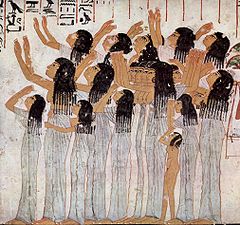
Tomb TT188, located in the necropolis of El-Khokha in Thebes in Egypt, is the tomb of the Steward and King's Cupbearer Parennefer. It has been excavated by the Akhenaten Temple Project. The work has been thoroughly published by Susan Redford with architectural study and drawings by Keith Meikle.

The Valley of the Kings, also known as the Valley of the Gates of the Kings, is a valley in Egypt where, for a period of nearly 500 years from the 16th to 11th century BC, rock-cut tombs were excavated for the pharaohs and powerful nobles of the New Kingdom.
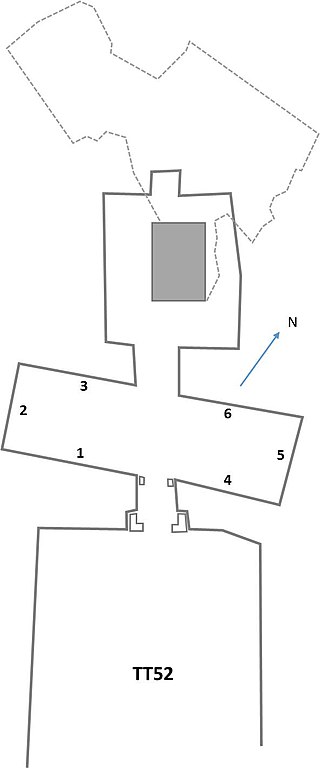
The Theban Tomb TT52 is located in Sheikh Abd el-Qurna, part of the Theban Necropolis, on the west bank of the Nile, opposite to Luxor. It is the burial place of Nakht, an ancient Egyptian official who held the position of a scribe and astronomer of Amun, probably during the reign of Thutmose IV during the Eighteenth Dynasty, the first dynasty of the New Kingdom.

The Ancient Egyptian noble, Ramose was Vizier under both Amenhotep III and Akhenaten. He was in office in the last decade of Amenhotep's III reign and at the beginning of the reign of the latter king. Ramose appears on jar labels found in the palace of king Amenhotep III at Malkata. Here appears also the vizier Amenhotep-Huy. Both viziers are also shown side by side in the temple of Soleb. In the New Kingdom the office of the vizier was divided in a northern vizier and a southern one. It is not entirely clear whether Ramose was the southern or northern one.

Southern Tomb 11 is an ancient sepulchre located at Amarna, Egypt. It was used for the burial of Ramose (General), whose titles included, "Royal scribe, Commander of troops of the Lord of the Two Lands, Steward of Nebmaatra ".

Theban Tomb 69 is located in Sheikh Abd el-Qurna, part of the Theban Necropolis, on the west bank of the Nile, opposite Luxor. It is the burial place of the ancient Egyptian official named Menna, whose titles included ‘Overseer of Fields of Amun’, and ‘Overseer of Fields of the Lord of the Two Lands’. Traditionally, TT 69 has been dated to the reign of Thutmosis IV. However, recent art historical studies of artistic style suggest the majority of the tomb was decorated during the reign of Amenhotep III.

The Theban Tomb TT100 is located in Sheikh Abd el-Qurna, part of the Theban Necropolis, on the west bank of the Nile, opposite to Luxor. It is the mortuary chapel of the ancient Egyptian vizier Rekhmire. There is no burial chamber next to this chapel. The vizier's tomb is elsewhere, perhaps even in the Valley of the Kings.

The Theban Tomb TT96 is located in Sheikh Abd el-Qurna. It forms part of the Theban Necropolis, situated on the west bank of the Nile opposite Luxor. The edifice is the burial place of the ancient Egyptian noble, Sennefer and wife Meryt.

The Theban Tomb TT60 is located in Sheikh Abd el-Qurna, part of the Theban Necropolis, on the west bank of the Nile, opposite to Luxor. It is the burial place of a woman called Senet. She was related to the ancient Egyptian Vizier Intefiqer. It is one of the earliest burials in the area.
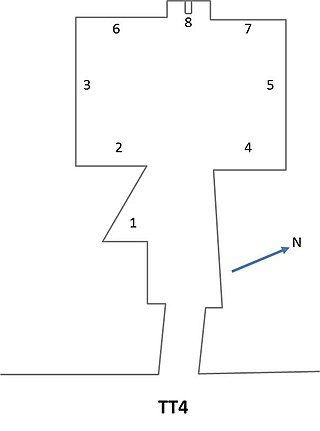
The Theban Tomb TT4 is located in Deir el-Medina, part of the Theban Necropolis, on the west bank of the Nile, opposite to Luxor. It is the burial place of the ancient Egyptian artisan named Qen.

The Theban Tomb TT16 is located in Dra' Abu el-Naga', part of the Theban Necropolis, on the west bank of the Nile, opposite to Luxor. It is the burial place of the ancient Egyptian Panehsy, who was Prophet of Amenhotep (I) of the Forecourt, during the reign of Ramesses II.
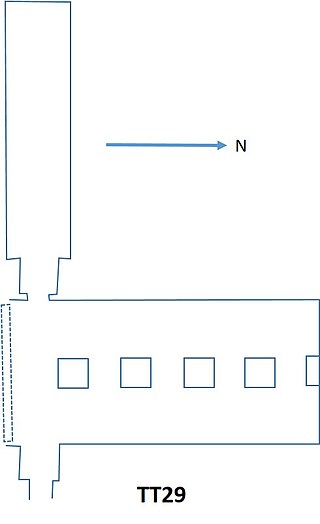
The Theban tomb TT29 is located in Sheikh Abd el-Qurna, part of the Theban Necropolis, on the west bank of the Nile, opposite to Luxor. It is the burial place of the ancient Egyptian noble Amenemopet called Pairy who was vizier and governor of Thebes.

Theban Tomb TT2 is located in Deir el-Medina, part of the Theban Necropolis, on the west bank of the Nile, opposite to Luxor. It is the burial place of the ancient Egyptian official, Khabekhnet, and his family. Khabekhnet was Servant in the Place of Truth, during the reign of Ramesses II.

Theban Tomb TT51 is located in Sheikh Abd el-Qurna, part of the Theban Necropolis, on the west bank of the Nile, opposite to Luxor. It is the burial place of the ancient Egyptian official Userhat, who was First Prophet of Sethi I during the 19th Dynasty.
The Theban Tomb TT5 is located in Deir el-Medina, part of the Theban Necropolis, on the west bank of the Nile, opposite to Luxor. It is the burial place of the ancient Egyptian artisan named Neferabet, who lived during the Ramesside period.
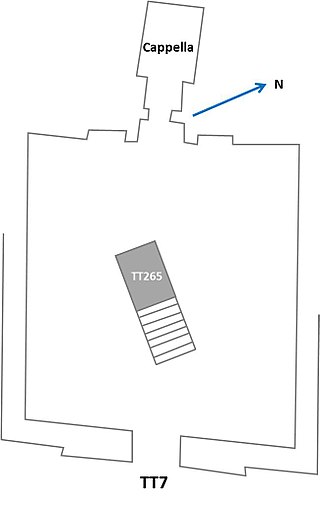
The Theban Tomb TT7 is located in Deir el-Medina, part of the Theban Necropolis, on the west bank of the Nile, opposite to Luxor. It is the burial place of the ancient Egyptian artisan named Ramose, who lived during the 19th Dynasty, during the reign of Ramesses II.

The Theban Tomb TT319 is located in Deir el-Bahari, part of the Theban Necropolis, on the west bank of the Nile, opposite to Luxor. The tomb belongs to the king's wife Neferu II, wife of the ancient Egyptian king Mentuhotep II. Neferu was the daughter of Queen Iah and Intef III.

The Theban Tomb TT46 is located in Sheikh Abd el-Qurna. It forms part of the Theban Necropolis, situated on the west bank of the Nile opposite Luxor.
The Theban Tomb TT48 is located in El-Khokha, part of the Theban Necropolis, on the west bank of the Nile, opposite to Luxor. TT48 was the burial place of the ancient Egyptian named Amenemhat called Surer, who was a Chief Steward, At the head of the King, Overseer of the Cattle of Amun. Amenemhat called Surer dates to the time of Amenhotep III from the middle of the Eighteenth Dynasty of Egypt. He was a son of Ith-taui, who was an overseer of the cattle of Amun and the lady Mut-tuy.
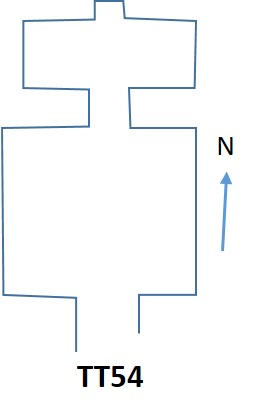
The Theban Tomb TT54 is located in Sheikh Abd el-Qurna, part of the Theban Necropolis, on the west bank of the Nile, opposite to Luxor. It was originally the burial place of the ancient Egyptian official Hui, who was an official during the reign of Thutmose IV and Amenhotep III. However, it was usurped later in the 19th Dynasty by another official, Kenro, and his son Khonsu.


